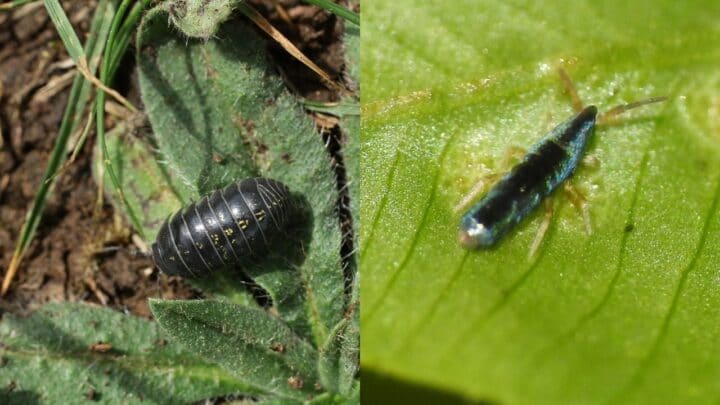While they’re a little creepy and very crawly, there are plenty of benefits when it comes to keeping and breeding springtails and isopods.
These soft-bodied bugs play a vital role in various ecosystems by feeding on decaying organic matter in gardens and vivariums. They also make a great team, as that which the one species doesn’t eat is usually vacuumed up by the other.
If you’re looking to culture or maintain a colony of isopods and springtails, you may be wondering what to feed them.
What to Feed Springtails and Isopods?
Both springtails and isopods are detritivores, which means that they feed on decomposing organic matter such as rotten leaves and bark. But, if you’re breeding them in culture tanks, springtails can be fed yeast, uncooked rice, or oatmeal. Isopods can be fed leaf litter, deadwood, good-quality fish flakes, or raw vegetables.
What to Feed Springtails
Springtails are tiny, much smaller than isopods, measuring in at only one-sixteenth of an inch (1 to 2 millimeters).
For this reason, they do not need to be fed all that frequently, depending on the size of your colony.
A few sprinkles of brewer’s yeast every 2 to 4 days should suffice in a culture tank. You can also feed them some grains of uncooked rice or oatmeal, gently misted with purified water.
Both rice and oatmeal grow mold and fungi easily, which springtails love to snack on.
If you notice a lot of food leftover in your culture tank, hold off feeding them until they have consumed their existing meal.
Too much food actively growing mold in a tank can use up oxygen resources and deprive your springtails of the air they need to thrive.
While some suggest fish flakes, mushrooms, and other vegetables as suitable foods for springtails, these can become detrimental if present in large volumes and can harbor and attract mite colonies.
What to Feed Isopods
Isopods are low-maintenance creatures and are generally happy in a very humid environment with plenty of (chemical-free) dead wood and decaying leaves to munch.
In a culture tank, you can supplement this diet by offering them additional plant-based foods on a weekly basis.
This includes leaf litter, quality fish flakes, or raw vegetable and fruit pieces, including carrot, apple, zucchini, or potato.
These types of nutrient-rich foods benefit isopods by providing them with much-needed calcium, vitamins, and minerals.
When feeding your isopods supplementary foods, only provide what your colony can manage to consume within 48 hours. Once their food is gone, wait for 1 to 2 days before giving them more.
Until you are confident about how much to feed them, always opt for less.
I would not recommend feeding isopods cereal or dog food, as some may recommend. These types of food tend to attract pests and mites.
Benefits of Springtails and Isopods
Springtails and isopods are often referred to as “tank janitors” or “clean-up crews,” as they are an essential part of maintaining the health of vivariums.
They feed on decaying matter, returning nutrients to the soil in a process known as a bioactive cycle.
Bioactivity implies that beneficial bugs feed on microorganisms in organic matter, such as fungi, algae, and bacteria, thereby effectively speeding up decomposition processes.
This occurs naturally in the wild but can be imitated in vivariums by replicating the natural environment and employing correct feeding procedures.
Can Springtails and Isopods Live Together
Springtails and isopods do well together in vivariums, precisely because their diets are quite different.
In a tank with other animals, springtails will live off of mold, fungi, algae, and fecal matter, whereas isopods may prefer to eat decaying wood and leaf litter.
Generally speaking, springtails and isopods complement one another beautifully when it comes to cleaning up vivariums.
They also serve as an excellent food source for various reptiles and amphibians, which in turn keeps their numbers manageable.
Do Springtails and Isopods Need Water
Both springtails and isopods rely on moisture and humidity for survival. When setting up culture tanks, you need to add water to your chosen substrate to provide your bugs with sufficient moisture to thrive.
Tanks can be regularly misted to avoid drying out of their environment.
Frequently Asked Questions about What to Feed Springtails and Isopods
Can you culture springtails and isopods in the same tank?
Absolutely. Springtails like to snack on the mold and fungus that grows in isopod culture tanks. Both types of bugs enjoy decaying plant matter too. However, co-culturing can present difficulties when it comes to removing one or the other from the tank or controlling population size.
Are springtails harmful to humans?
Springtails present no threat to humans and are mostly considered a nuisance pest. They may infest homes after heavy periods of rain, as they are attracted to dampness, humidity, and light. While they may be annoying, they will not physically damage you or your home.
Are isopods harmful to humans?
Isopods aren’t harmful to humans. However, given the thousands of species of isopods, some are certainly more capable of causing harm overall. Some parasitic isopods, for example, are known to feed on the tongues of fish. Some also bore holes in wood and timber. The common isopod breeds kept in vivariums are generally harmless.
Conclusion
They may not be everyone’s cup of tea, but springtails and isopods play a beneficial role in maintaining the health of the environments they find themselves in.
Indeed, there is a strange magic to culturing ecosystems that, over time, become self-sustaining. And the best news is, it’s not at all difficult.
Serving them good food does wonders when breeding these bountiful bugs.


